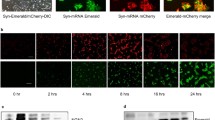Abstract
The ability to differentiate pluripotent stem cells and to generate specific cell types is a long-standing goal of regenerative medicine. This can be accomplished by recreating the developmental trajectories using sequential activation of the corresponding signaling pathways, or more recently—by direct programming of cell identities using lineage-specific transcription factors. Notably, to be functional in cell replacement therapies, generation of complex cell types, such as specialized neuronal sub-types of the brain, requires precise induction of molecular profiles and regional specification of the cells. However, the induction of the correct cellular identity and marker gene expression can be hampered by technical challenges, one of which is the robust co-expression of multiple transcription factors that is often required for correct cell identity specification. Here, we describe in detail a method for co-expression of seven transcription factors required for efficient induction of dopaminergic neurons with midbrain characteristics from human embryonic and induced pluripotent stem cells.
Access this chapter
Tax calculation will be finalised at checkout
Purchases are for personal use only
Similar content being viewed by others
References
Yamanaka S (2020) Pluripotent stem cell-based cell therapy—promise and challenges. Cell Stem Cell 27:523–531. https://doi.org/10.1016/j.stem.2020.09.014
Hanna JH, Saha K, Jaenisch R (2010) Pluripotency and cellular reprogramming: facts, hypotheses, unresolved issues. Cell 143:508–525. https://doi.org/10.1016/j.cell.2010.10.008
Blanpain C, Daley GQ, Hochedlinger K, Passegué E, Rossant J, Yamanaka S (2012) Stem cells assessed. Nat Rev Mol Cell Biol 13:471–476. https://doi.org/10.1038/nrm3371
Okita K, Yamanaka S (2011) Induced pluripotent stem cells: opportunities and challenges. Philos Trans R Soc, B 366:2198–2207. https://doi.org/10.1098/rstb.2011.0016
Limone F, Klim JR, Mordes DA (2022) Pluripotent stem cell strategies for rebuilding the human brain. Front Aging Neurosci 14:1017299
Kim TW, Koo SY, Studer L (2020) Pluripotent stem cell therapies for Parkinson’s disease: present challenges and future opportunities. Front Cell Dev Biol 8:729
Wang H, Yang Y, Liu J, Qian L (2021) Direct cell reprogramming: approaches, mechanisms and progress. Nat Rev Mol Cell Biol 22:410–424. https://doi.org/10.1038/s41580-021-00335-z
Zhang Y, Pak C, Han Y, Ahlenius H, Zhang Z, Chanda S, Marro S, Patzke C, Acuna C, Covy J, Xu W, Yang N, Danko T, Chen L, Wernig M, Sudhof TC (2013) Rapid single-step induction of functional neurons from human pluripotent stem cells. Neuron 78:785–798. https://doi.org/10.1016/j.neuron.2013.05.029
Ng YH, Chanda S, Janas JA, Yang N, Kokubu Y, Südhof TC, Wernig M (2021) Efficient generation of dopaminergic induced neuronal cells with midbrain characteristics. Stem Cell Rep 16:1763–1776. https://doi.org/10.1016/j.stemcr.2021.05.017
Yang N, Chanda S, Marro S, Ng YH, Janas JA, Haag D, Ang CE, Tang Y, Flores Q, Mall M, Wapinski O, Li M, Ahlenius H, Rubenstein JL, Chang HY, Buylla AA, Sudhof TC, Wernig M (2017) Generation of pure GABAergic neurons by transcription factor programming. Nat Methods 14:621–628. https://doi.org/10.1038/nmeth.4291
Author information
Authors and Affiliations
Corresponding authors
Editor information
Editors and Affiliations
Rights and permissions
Copyright information
© 2023 The Author(s), under exclusive license to Springer Science+Business Media, LLC, part of Springer Nature
About this protocol
Cite this protocol
Ng, Y., Janas, J.A. (2023). Transcription Factor-Directed Dopaminergic Neuron Differentiation from Human Pluripotent Stem Cells. In: Huang, YW.A., Pak, C. (eds) Stem Cell-Based Neural Model Systems for Brain Disorders. Methods in Molecular Biology, vol 2683. Humana, New York, NY. https://doi.org/10.1007/978-1-0716-3287-1_4
Download citation
DOI: https://doi.org/10.1007/978-1-0716-3287-1_4
Published:
Publisher Name: Humana, New York, NY
Print ISBN: 978-1-0716-3286-4
Online ISBN: 978-1-0716-3287-1
eBook Packages: Springer Protocols




